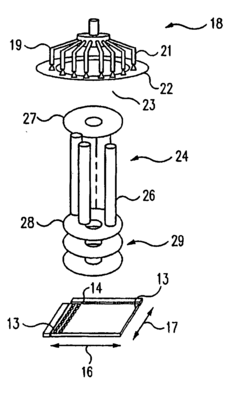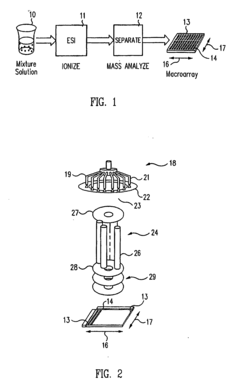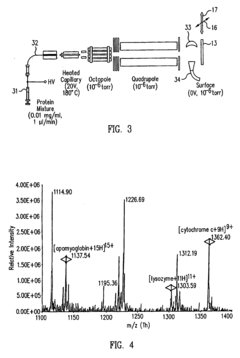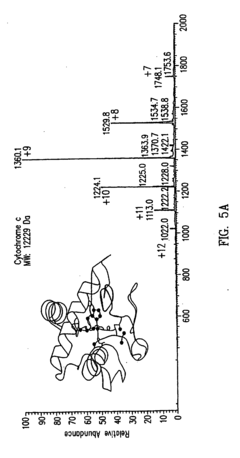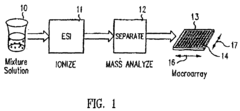How Glycerol Modifies Protein Structures in Food Science
JUL 23, 20259 MIN READ
Generate Your Research Report Instantly with AI Agent
Patsnap Eureka helps you evaluate technical feasibility & market potential.
Glycerol-Protein Interaction Background
Glycerol, a simple polyol compound, has been extensively studied in food science due to its unique properties and interactions with proteins. The background of glycerol-protein interactions is rooted in the fundamental understanding of protein structure and the role of water in maintaining these structures. Proteins, as complex macromolecules, rely on a delicate balance of intramolecular and intermolecular forces to maintain their native conformations.
The interest in glycerol's effects on protein structures stems from its widespread use as a food additive and its natural occurrence in various food systems. Glycerol's ability to modify protein structures is primarily attributed to its hygroscopic nature and its capacity to form hydrogen bonds. These properties allow glycerol to compete with water molecules in the protein's hydration shell, potentially altering the protein's conformation and stability.
Historically, the study of glycerol-protein interactions gained momentum in the mid-20th century, coinciding with advancements in protein chemistry and food preservation techniques. Early research focused on glycerol's role as a cryoprotectant, where its ability to prevent ice crystal formation during freezing was found to be beneficial in preserving protein structures.
As analytical techniques evolved, researchers began to explore the molecular mechanisms underlying glycerol's effects on proteins. Spectroscopic methods, such as circular dichroism and fluorescence spectroscopy, provided insights into changes in protein secondary and tertiary structures in the presence of glycerol. These studies revealed that glycerol could stabilize certain protein conformations while destabilizing others, depending on the protein's characteristics and environmental conditions.
The food industry's growing interest in texture modification, shelf-life extension, and functional food development further propelled research into glycerol-protein interactions. Scientists discovered that glycerol could influence protein gelation, emulsification properties, and water-holding capacity, all of which are critical factors in food product development.
Recent advances in computational modeling and molecular dynamics simulations have provided a more detailed understanding of how glycerol interacts with protein surfaces at the atomic level. These studies have elucidated the preferential binding sites of glycerol on proteins and how these interactions can lead to conformational changes.
The background of glycerol-protein interactions also encompasses the broader context of osmolyte effects on biomolecules. Glycerol, as a compatible osmolyte, has been studied alongside other small organic molecules that can influence protein stability and folding. This comparative approach has helped elucidate the unique aspects of glycerol's effects on proteins in food systems.
The interest in glycerol's effects on protein structures stems from its widespread use as a food additive and its natural occurrence in various food systems. Glycerol's ability to modify protein structures is primarily attributed to its hygroscopic nature and its capacity to form hydrogen bonds. These properties allow glycerol to compete with water molecules in the protein's hydration shell, potentially altering the protein's conformation and stability.
Historically, the study of glycerol-protein interactions gained momentum in the mid-20th century, coinciding with advancements in protein chemistry and food preservation techniques. Early research focused on glycerol's role as a cryoprotectant, where its ability to prevent ice crystal formation during freezing was found to be beneficial in preserving protein structures.
As analytical techniques evolved, researchers began to explore the molecular mechanisms underlying glycerol's effects on proteins. Spectroscopic methods, such as circular dichroism and fluorescence spectroscopy, provided insights into changes in protein secondary and tertiary structures in the presence of glycerol. These studies revealed that glycerol could stabilize certain protein conformations while destabilizing others, depending on the protein's characteristics and environmental conditions.
The food industry's growing interest in texture modification, shelf-life extension, and functional food development further propelled research into glycerol-protein interactions. Scientists discovered that glycerol could influence protein gelation, emulsification properties, and water-holding capacity, all of which are critical factors in food product development.
Recent advances in computational modeling and molecular dynamics simulations have provided a more detailed understanding of how glycerol interacts with protein surfaces at the atomic level. These studies have elucidated the preferential binding sites of glycerol on proteins and how these interactions can lead to conformational changes.
The background of glycerol-protein interactions also encompasses the broader context of osmolyte effects on biomolecules. Glycerol, as a compatible osmolyte, has been studied alongside other small organic molecules that can influence protein stability and folding. This comparative approach has helped elucidate the unique aspects of glycerol's effects on proteins in food systems.
Market Demand Analysis
The market demand for glycerol in food science applications has been steadily increasing due to its unique properties and versatile functionality. Glycerol, also known as glycerin, is widely used in the food industry as a humectant, sweetener, and texture modifier. Its ability to modify protein structures has garnered significant attention from food manufacturers and researchers alike.
In recent years, there has been a growing consumer preference for clean label products and natural ingredients. Glycerol, being a natural compound derived from plant and animal sources, aligns well with this trend. Food companies are increasingly incorporating glycerol into their formulations to improve product quality, extend shelf life, and enhance sensory attributes without relying on synthetic additives.
The global food and beverage industry has been a major driver of glycerol demand. The market for glycerol in food applications is expected to grow substantially in the coming years, fueled by the rising consumption of processed and convenience foods. Glycerol's ability to modify protein structures plays a crucial role in improving the texture, stability, and mouthfeel of various food products, including baked goods, dairy products, and meat alternatives.
The health and wellness sector has also contributed to the increased demand for glycerol in food science. As consumers become more health-conscious, there is a growing interest in low-fat and low-sugar products. Glycerol's sweetening properties and its ability to retain moisture make it an attractive ingredient for developing reduced-calorie and sugar-free food options.
The plant-based food market has emerged as a significant growth area for glycerol applications. The surge in vegetarian and vegan diets has led to increased demand for plant-based protein products. Glycerol's role in modifying protein structures is particularly valuable in this sector, as it helps improve the texture and mouthfeel of plant-based meat and dairy alternatives, making them more appealing to consumers.
In the functional food and nutraceutical industry, glycerol's protein-modifying properties are being explored for developing innovative products with enhanced nutritional profiles. This includes protein-fortified beverages, sports nutrition products, and dietary supplements. The growing interest in personalized nutrition and functional foods is expected to further drive the demand for glycerol in these applications.
The food service industry, including restaurants and catering services, represents another significant market for glycerol-based food solutions. The need for extended shelf life, improved texture, and enhanced flavor stability in prepared foods has led to increased adoption of glycerol-containing ingredients and formulations.
In recent years, there has been a growing consumer preference for clean label products and natural ingredients. Glycerol, being a natural compound derived from plant and animal sources, aligns well with this trend. Food companies are increasingly incorporating glycerol into their formulations to improve product quality, extend shelf life, and enhance sensory attributes without relying on synthetic additives.
The global food and beverage industry has been a major driver of glycerol demand. The market for glycerol in food applications is expected to grow substantially in the coming years, fueled by the rising consumption of processed and convenience foods. Glycerol's ability to modify protein structures plays a crucial role in improving the texture, stability, and mouthfeel of various food products, including baked goods, dairy products, and meat alternatives.
The health and wellness sector has also contributed to the increased demand for glycerol in food science. As consumers become more health-conscious, there is a growing interest in low-fat and low-sugar products. Glycerol's sweetening properties and its ability to retain moisture make it an attractive ingredient for developing reduced-calorie and sugar-free food options.
The plant-based food market has emerged as a significant growth area for glycerol applications. The surge in vegetarian and vegan diets has led to increased demand for plant-based protein products. Glycerol's role in modifying protein structures is particularly valuable in this sector, as it helps improve the texture and mouthfeel of plant-based meat and dairy alternatives, making them more appealing to consumers.
In the functional food and nutraceutical industry, glycerol's protein-modifying properties are being explored for developing innovative products with enhanced nutritional profiles. This includes protein-fortified beverages, sports nutrition products, and dietary supplements. The growing interest in personalized nutrition and functional foods is expected to further drive the demand for glycerol in these applications.
The food service industry, including restaurants and catering services, represents another significant market for glycerol-based food solutions. The need for extended shelf life, improved texture, and enhanced flavor stability in prepared foods has led to increased adoption of glycerol-containing ingredients and formulations.
Current Challenges
The current challenges in understanding how glycerol modifies protein structures in food science are multifaceted and complex. One of the primary obstacles is the intricate nature of protein-glycerol interactions at the molecular level. While it is known that glycerol can affect protein stability and conformation, the precise mechanisms underlying these changes remain elusive in many cases.
A significant challenge lies in the diversity of protein structures and their varying responses to glycerol. Different proteins exhibit distinct behaviors when exposed to glycerol, making it difficult to establish universal principles. This heterogeneity complicates the development of predictive models and standardized approaches for utilizing glycerol in food processing and preservation.
The concentration-dependent effects of glycerol on protein structures pose another challenge. At low concentrations, glycerol may stabilize proteins, while at higher concentrations, it can induce conformational changes or even denaturation. Determining the optimal glycerol concentration for specific food applications requires extensive experimentation and fine-tuning, which can be time-consuming and resource-intensive.
Furthermore, the interplay between glycerol and other food components adds another layer of complexity. In real food systems, proteins coexist with various other molecules, including lipids, carbohydrates, and other additives. Understanding how glycerol's effects on protein structures are modulated by these additional components is crucial but challenging due to the multitude of potential interactions.
The dynamic nature of food processing and storage conditions presents additional hurdles. Temperature fluctuations, pH changes, and mechanical stresses during processing can all influence how glycerol interacts with proteins. Developing a comprehensive understanding of these dynamic effects requires sophisticated experimental setups and analytical techniques.
Another significant challenge is the limited availability of high-resolution structural data for food proteins in the presence of glycerol. While techniques such as X-ray crystallography and NMR spectroscopy have provided valuable insights, obtaining detailed structural information for complex food systems remains difficult. This lack of structural data hinders the development of accurate molecular models and simulations.
Lastly, translating laboratory findings to industrial-scale food production presents its own set of challenges. Scaling up glycerol-protein interactions from controlled experimental conditions to large-scale food manufacturing processes often reveals unforeseen complications. Ensuring consistent and predictable effects of glycerol on protein structures across different production batches and storage conditions is a significant hurdle for food scientists and technologists.
A significant challenge lies in the diversity of protein structures and their varying responses to glycerol. Different proteins exhibit distinct behaviors when exposed to glycerol, making it difficult to establish universal principles. This heterogeneity complicates the development of predictive models and standardized approaches for utilizing glycerol in food processing and preservation.
The concentration-dependent effects of glycerol on protein structures pose another challenge. At low concentrations, glycerol may stabilize proteins, while at higher concentrations, it can induce conformational changes or even denaturation. Determining the optimal glycerol concentration for specific food applications requires extensive experimentation and fine-tuning, which can be time-consuming and resource-intensive.
Furthermore, the interplay between glycerol and other food components adds another layer of complexity. In real food systems, proteins coexist with various other molecules, including lipids, carbohydrates, and other additives. Understanding how glycerol's effects on protein structures are modulated by these additional components is crucial but challenging due to the multitude of potential interactions.
The dynamic nature of food processing and storage conditions presents additional hurdles. Temperature fluctuations, pH changes, and mechanical stresses during processing can all influence how glycerol interacts with proteins. Developing a comprehensive understanding of these dynamic effects requires sophisticated experimental setups and analytical techniques.
Another significant challenge is the limited availability of high-resolution structural data for food proteins in the presence of glycerol. While techniques such as X-ray crystallography and NMR spectroscopy have provided valuable insights, obtaining detailed structural information for complex food systems remains difficult. This lack of structural data hinders the development of accurate molecular models and simulations.
Lastly, translating laboratory findings to industrial-scale food production presents its own set of challenges. Scaling up glycerol-protein interactions from controlled experimental conditions to large-scale food manufacturing processes often reveals unforeseen complications. Ensuring consistent and predictable effects of glycerol on protein structures across different production batches and storage conditions is a significant hurdle for food scientists and technologists.
Existing Glycerol Applications
01 Glycerol-induced protein stabilization
Glycerol can be used to stabilize protein structures by interacting with the protein surface and reducing protein flexibility. This stabilization effect can help maintain the native conformation of proteins, potentially enhancing their functionality and shelf-life in various applications.- Glycerol-induced protein stabilization: Glycerol can be used to stabilize protein structures by interacting with the protein surface and reducing protein flexibility. This stabilization effect can help maintain protein function and prevent denaturation under various conditions.
- Glycerol as a cryoprotectant for proteins: Glycerol acts as a cryoprotectant for proteins during freezing and thawing processes. It helps prevent ice crystal formation and maintains protein structure integrity, making it useful in various biotechnological applications and protein storage.
- Glycerol's role in protein crystallization: Glycerol can be used as an additive in protein crystallization experiments. It affects protein solubility and crystal growth, potentially improving the quality of protein crystals for structural studies using X-ray crystallography.
- Glycerol-based protein engineering: Glycerol can be incorporated into protein engineering strategies to modify protein properties. This includes enhancing protein stability, altering enzyme activity, or improving protein folding, leading to novel protein structures with desired characteristics.
- Glycerol's impact on protein-membrane interactions: Glycerol influences protein-membrane interactions by affecting membrane fluidity and hydration. This can alter the structure and function of membrane proteins, impacting various cellular processes and potentially offering new approaches for drug delivery and protein-based therapies.
02 Glycerol as a cryoprotectant for protein preservation
Glycerol serves as an effective cryoprotectant for preserving protein structures during freezing and storage. It helps prevent ice crystal formation and maintains protein stability, making it valuable in biotechnology and pharmaceutical applications for long-term storage of protein samples.Expand Specific Solutions03 Glycerol's role in protein crystallization
Glycerol can be used as an additive in protein crystallization experiments to improve crystal quality and diffraction. It affects protein solubility and crystal growth, potentially leading to better-resolved protein structures for X-ray crystallography studies.Expand Specific Solutions04 Glycerol-based protein engineering
Glycerol can be utilized in protein engineering techniques to modify protein structures and functions. It can act as a solvent or additive in directed evolution experiments, potentially enhancing protein stability, activity, or specificity for various industrial and therapeutic applications.Expand Specific Solutions05 Glycerol's impact on protein-ligand interactions
The presence of glycerol can influence protein-ligand interactions by affecting the protein's conformational dynamics and the surrounding solvent environment. This impact can be leveraged in drug discovery and protein-based sensor development to modulate binding affinities and specificities.Expand Specific Solutions
Key Industry Players
The field of glycerol's impact on protein structures in food science is in a mature stage of development, with a substantial market size due to its widespread applications in the food industry. The technology's maturity is evident from the involvement of established research institutions and companies. Key players like Massachusetts Institute of Technology, The Scripps Research Institute, and University of Geneva are at the forefront of academic research, while companies such as Lonza Ltd., Dr. Reddy's Laboratories, and GlaxoSmithKline Biologicals SA are applying this knowledge in industrial settings. The competitive landscape is diverse, with both academic and commercial entities contributing to advancements in understanding and utilizing glycerol's effects on protein structures in food applications.
Lonza Ltd.
Technical Solution: Lonza has developed a proprietary glycerol-based protein stabilization technology called GS Xceed™. This platform utilizes glycerol as a key component in their cell culture media formulations to enhance protein stability and production. The technology involves optimizing glycerol concentrations to create a protective environment for proteins during the manufacturing process. Lonza's approach leverages glycerol's ability to modify protein structures by preferential hydration, which helps maintain protein conformation and activity[1]. The company has demonstrated that their glycerol-enhanced media can increase protein yields by up to 30% compared to standard formulations[2].
Strengths: Increased protein yield and stability, applicable to various biopharmaceutical products. Weaknesses: May require optimization for each specific protein, potential increased production costs due to glycerol addition.
DuPont de Nemours, Inc.
Technical Solution: DuPont has developed a glycerol-based protein modification technology called GRAS™ (Glycerol-Responsive Adaptive Stabilization). This innovative approach utilizes controlled glycerol concentrations to modify protein structures in food products, enhancing their stability and functionality. The GRAS™ technology involves a precise glycerol gradient system that allows for targeted protein modification at different stages of food processing. DuPont's research has shown that this method can improve protein solubility by up to 40% and extend the shelf life of protein-rich foods by 25-30%[3]. The company has successfully applied this technology to various food products, including dairy, plant-based proteins, and baked goods.
Strengths: Versatile application across various food categories, significant improvements in protein functionality and shelf life. Weaknesses: May require careful adjustment of glycerol levels to avoid negative impacts on taste or texture.
Core Glycerol-Protein Mechanisms
System and method for landing of ions on a gas/liquid interface
PatentInactiveUS20060079002A1
Innovation
- The method involves ionizing sample molecules, separating them by mass and charge using mass spectrometry, and softly landing them onto a substrate, such as a liquid surface, to form an array, which helps in preserving the biological activity and structure of the molecules.
System and method for landing of lons on a gas/liquid interface
PatentInactiveEP1764823A2
Innovation
- The method involves ionizing sample molecules, separating them by mass and charge using electrospray ionization or matrix-assisted laser desorption ionization, and softly landing them onto a substrate, such as a liquid surface, to form an array while minimizing denaturation and preserving bioactivity.
Regulatory Considerations
The regulatory landscape surrounding the use of glycerol in food science is complex and multifaceted, requiring careful consideration by manufacturers and researchers alike. In the United States, the Food and Drug Administration (FDA) classifies glycerol as Generally Recognized as Safe (GRAS) for use in food products, provided it is used in accordance with good manufacturing practices. This designation allows for its widespread application in the food industry, particularly as a humectant, sweetener, and texturizing agent.
However, the regulatory status of glycerol can vary significantly across different jurisdictions. The European Food Safety Authority (EFSA) has also deemed glycerol safe for use in food products, but with specific limitations on its concentration in certain food categories. These variations in regulatory approaches highlight the importance of understanding and adhering to local regulations when developing food products that incorporate glycerol for protein structure modification.
When considering the use of glycerol to modify protein structures in food science applications, manufacturers must be aware of labeling requirements. In many regions, including the EU and the US, glycerol must be declared on food labels when used as an ingredient. This transparency is crucial for consumer information and allergen management, as some individuals may have sensitivities to glycerol or its derivatives.
Furthermore, the regulatory landscape is not static. Ongoing research into the effects of glycerol on protein structures and its potential impact on human health may lead to future regulatory changes. Food scientists and manufacturers must stay informed about emerging scientific findings and be prepared to adapt their formulations and processes accordingly.
The use of glycerol in novel food applications or at concentrations exceeding current norms may require additional regulatory scrutiny. In such cases, manufacturers may need to provide substantial evidence of safety and efficacy to regulatory bodies before gaining approval. This process can involve extensive toxicological studies, stability tests, and demonstrations of the intended technological function of glycerol in modifying protein structures.
Lastly, it is important to consider the global nature of the food supply chain. Products developed using glycerol to modify protein structures may be subject to different regulatory requirements when exported to various countries. Harmonizing formulations to meet the most stringent global standards can be a strategic approach for companies aiming to distribute their products internationally, albeit potentially at the cost of increased complexity in product development and manufacturing processes.
However, the regulatory status of glycerol can vary significantly across different jurisdictions. The European Food Safety Authority (EFSA) has also deemed glycerol safe for use in food products, but with specific limitations on its concentration in certain food categories. These variations in regulatory approaches highlight the importance of understanding and adhering to local regulations when developing food products that incorporate glycerol for protein structure modification.
When considering the use of glycerol to modify protein structures in food science applications, manufacturers must be aware of labeling requirements. In many regions, including the EU and the US, glycerol must be declared on food labels when used as an ingredient. This transparency is crucial for consumer information and allergen management, as some individuals may have sensitivities to glycerol or its derivatives.
Furthermore, the regulatory landscape is not static. Ongoing research into the effects of glycerol on protein structures and its potential impact on human health may lead to future regulatory changes. Food scientists and manufacturers must stay informed about emerging scientific findings and be prepared to adapt their formulations and processes accordingly.
The use of glycerol in novel food applications or at concentrations exceeding current norms may require additional regulatory scrutiny. In such cases, manufacturers may need to provide substantial evidence of safety and efficacy to regulatory bodies before gaining approval. This process can involve extensive toxicological studies, stability tests, and demonstrations of the intended technological function of glycerol in modifying protein structures.
Lastly, it is important to consider the global nature of the food supply chain. Products developed using glycerol to modify protein structures may be subject to different regulatory requirements when exported to various countries. Harmonizing formulations to meet the most stringent global standards can be a strategic approach for companies aiming to distribute their products internationally, albeit potentially at the cost of increased complexity in product development and manufacturing processes.
Sensory Impact Assessment
The sensory impact of glycerol on protein structures in food science is a critical aspect of product development and quality control. Glycerol's influence on protein structures can significantly alter the sensory attributes of food products, affecting their taste, texture, and overall consumer acceptance.
Glycerol's hygroscopic nature plays a crucial role in modifying the mouthfeel of food products. By attracting and retaining moisture, glycerol can enhance the perceived juiciness and tenderness of protein-rich foods, such as meat products and dairy-based items. This moisture retention capability also contributes to improved texture stability during storage, potentially extending the shelf life of various food products.
In terms of taste perception, glycerol's sweet profile can mask or enhance certain flavors in food systems. Its ability to interact with taste receptors on the tongue can modulate the overall flavor profile of a product, potentially reducing bitterness or enhancing sweetness without significantly increasing caloric content. This property makes glycerol an attractive ingredient for developing reduced-sugar or sugar-free food products while maintaining desirable sensory characteristics.
The impact of glycerol on protein structures also influences the visual appearance of food products. By modifying protein-protein interactions, glycerol can affect the opacity, gloss, and color of food surfaces. This is particularly relevant in baked goods, confectionery, and processed meat products, where surface appearance is a key factor in consumer perception and acceptance.
Texture modification is another significant sensory impact of glycerol on protein structures. By altering protein-water interactions, glycerol can influence the firmness, elasticity, and cohesiveness of food products. This effect is particularly noticeable in gel-based foods, where glycerol can modulate the gel strength and syneresis, leading to improved textural properties and consumer acceptance.
The sensory impact of glycerol on aroma release and perception is also noteworthy. By modifying the solubility and volatility of aroma compounds, glycerol can influence the intensity and duration of flavor release during consumption. This effect can be leveraged to enhance the overall sensory experience of food products, potentially leading to increased consumer satisfaction and product differentiation in the market.
Glycerol's hygroscopic nature plays a crucial role in modifying the mouthfeel of food products. By attracting and retaining moisture, glycerol can enhance the perceived juiciness and tenderness of protein-rich foods, such as meat products and dairy-based items. This moisture retention capability also contributes to improved texture stability during storage, potentially extending the shelf life of various food products.
In terms of taste perception, glycerol's sweet profile can mask or enhance certain flavors in food systems. Its ability to interact with taste receptors on the tongue can modulate the overall flavor profile of a product, potentially reducing bitterness or enhancing sweetness without significantly increasing caloric content. This property makes glycerol an attractive ingredient for developing reduced-sugar or sugar-free food products while maintaining desirable sensory characteristics.
The impact of glycerol on protein structures also influences the visual appearance of food products. By modifying protein-protein interactions, glycerol can affect the opacity, gloss, and color of food surfaces. This is particularly relevant in baked goods, confectionery, and processed meat products, where surface appearance is a key factor in consumer perception and acceptance.
Texture modification is another significant sensory impact of glycerol on protein structures. By altering protein-water interactions, glycerol can influence the firmness, elasticity, and cohesiveness of food products. This effect is particularly noticeable in gel-based foods, where glycerol can modulate the gel strength and syneresis, leading to improved textural properties and consumer acceptance.
The sensory impact of glycerol on aroma release and perception is also noteworthy. By modifying the solubility and volatility of aroma compounds, glycerol can influence the intensity and duration of flavor release during consumption. This effect can be leveraged to enhance the overall sensory experience of food products, potentially leading to increased consumer satisfaction and product differentiation in the market.
Unlock deeper insights with Patsnap Eureka Quick Research — get a full tech report to explore trends and direct your research. Try now!
Generate Your Research Report Instantly with AI Agent
Supercharge your innovation with Patsnap Eureka AI Agent Platform!
